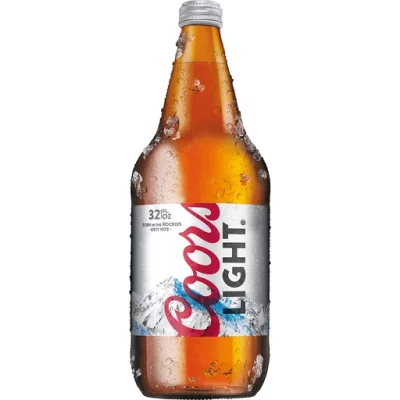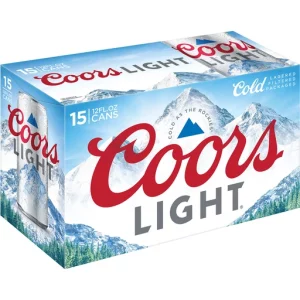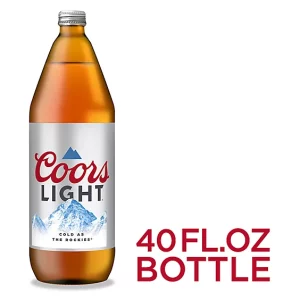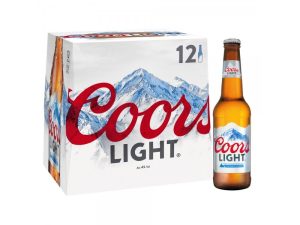Coors Light is one of the most popular beer brands in the world, known for its refreshing taste and crisp flavor. One of the key factors that contribute to its popularity is its alcohol by volume (ABV) content. Coors Light ABV is relatively low compared to other beers, making it a popular choice for those who enjoy a beer without a high alcohol content.
In this blog post, we’ll explore everything you need to know about Coors Light ABV, from its definition and measurement to its impact on taste, health, and safety. Whether you’re a beer enthusiast or just curious about Coors Light’s ABV content, this post has got you covered. So, let’s dive in.
Coors Light and its popularity
Coors Light is a well-known beer brand that has gained popularity across the globe. It is produced by the Coors Brewing Company, which was founded in 1873 in Golden, Colorado, USA. Coors Light was first introduced in 1978 as a light beer option for consumers. Since then, it has become one of the best-selling beers in the United States and is now available in over 25 countries worldwide.
One of the main reasons for Coors Light’s popularity is its refreshing taste and crisp flavor. The beer is brewed using high-quality malted barley, corn, and water, which gives it a smooth and light taste. In addition, the beer is filtered using a unique process that removes impurities, resulting in a clear and refreshing beverage.
Coors Light has also gained popularity for its marketing campaigns, which have been highly successful in reaching its target audience. The brand’s advertising campaigns often feature slogans such as “The World’s Most Refreshing Beer” and “Rocky Mountain Cold Refreshment,” which have resonated with consumers and helped to reinforce the beer’s image as a refreshing and high-quality option.
Overall, Coors Light’s combination of refreshing taste, high-quality ingredients, and successful marketing campaigns have helped to make it a popular choice among beer drinkers worldwide.
What are ABV and its importance in alcoholic beverages?
ABV stands for “alcohol by volume,” which is a measure of the amount of alcohol present in an alcoholic beverage. It is expressed as a percentage of the total volume of the beverage. For example, if a beer has an ABV of 5%, it means that 5% of its total volume is pure alcohol.
The ABV of an alcoholic beverage is important for a number of reasons. Firstly, it determines how much alcohol a person is consuming when they drink the beverage. This is important for regulating alcohol consumption and for ensuring that people do not drink too much alcohol, which can lead to negative health consequences.
Secondly, ABV can impact the taste and flavor of an alcoholic beverage. High-ABV beverages such as whiskey or brandy, for example, can have a stronger and more complex flavor than lower-ABV beverages like beer or wine.
ABV can also impact the cost of an alcoholic beverage. Beverages with a higher ABV typically have a higher cost because they contain more alcohol, which is subject to higher taxes and regulations in many countries.
Finally, ABV is an important consideration for those who are brewing or distilling alcoholic beverages. Accurately measuring ABV is essential for ensuring that the beverage is consistent in terms of taste, flavor, and strength, and for complying with regulatory requirements.
Overall, ABV is an important measure of alcohol content in alcoholic beverages, with implications for taste, health, cost, and regulation.
ABV of Coors Light: How it is determined and measured
The ABV of Coors Light, like other alcoholic beverages, is determined and measured through a process called distillation. Distillation involves separating the alcohol from the other components in the beverage through a process of heating and condensation.
To determine the ABV of Coors Light, a sample of the beer is first taken and weighed. The sample is then heated to vaporize the alcohol, which is then condensed and collected. The amount of alcohol collected is measured and compared to the original weight of the sample to calculate the ABV.
The measurement of ABV is typically expressed as a percentage, such as 4% or 5%, and can vary depending on the region in which the beer is produced. For example, the ABV of Coors Light in the United States is 4.2%, while in Canada it is 4%.
It is important to note that while the ABV of Coors Light is relatively low compared to other beers, it still contains alcohol and should be consumed responsibly. Overconsumption of alcohol can lead to negative health consequences, and it is important to always drink in moderation.
Coors Light ABV variations in different countries
The ABV of Coors Light can vary slightly depending on the country in which it is produced and sold. While the overall ABV of Coors Light is relatively low compared to other beers, there can be minor differences in alcohol content based on regional regulations and production processes.
In the United States, Coors Light has an ABV of 4.2%, which is a relatively standard alcohol content for a light beer. In Canada, the ABV of Coors Light is also 4%, making it slightly lower than its American counterpart.
In some European countries, such as the United Kingdom and Ireland, the ABV of Coors Light is slightly higher than in North America, at around 4.3%. This is likely due to different regulatory requirements and production methods.
It is important to note that regardless of the minor variations in ABV, Coors Light remains a relatively low-alcohol option compared to other beers and alcoholic beverages. As with all alcohol, it should be consumed responsibly and in moderation to avoid negative health consequences.
Comparison of Coors Light ABV with other popular beer brands
Coors Light is a popular beer brand known for its light and refreshing taste. Compared to other popular beer brands, Coors Light has a relatively low ABV (alcohol by volume) percentage.
Here are some examples of other popular beer brands and their ABV:
- Bud Light: Bud Light is a light beer brand that is similar in style and taste to Coors Light. However, it has a slightly higher ABV percentage, with 4.2% in the United States and 3.5% in Canada.
- Corona Extra: Corona Extra is a popular Mexican beer that is often served with a wedge of lime. It has a slightly higher ABV than Coors Light, with 4.5%.
- Heineken: Heineken is a Dutch beer brand that is popular worldwide. It has a higher ABV than Coors Light, with 5%.
- Guinness Draught: Guinness Draught is an Irish beer that is known for its dark color and creamy texture. It has a much higher ABV than Coors Light, with 4.2% in the United States and 4.1% in Ireland.
- Stella Artois: Stella Artois is a Belgian beer that is known for its crisp and refreshing taste. It has a slightly higher ABV than Coors Light, with 5.2%.
Overall, while Coors Light has a lower ABV than some other popular beer brands, it remains a popular choice for those who prefer a light and refreshing beer. As with all alcoholic beverages, it is important to drink responsibly and in moderation.
Coors Light ABV and its impact on the taste and flavor of the beer
The ABV (alcohol by volume) of Coors Light is relatively low compared to many other beers, which can impact the taste and flavor of the beer. The lower alcohol content means that Coors Light has a lighter body and a smoother, less bitter taste than many other beers.
With its ABV of 4.2%, Coors Light is classified as a light beer, which generally means that it has a lower calorie count and less alcohol than other types of beer. The lower ABV allows the flavors of the beer to come through more clearly, making it a popular choice for those who prefer a milder beer taste.
While the lower ABV of Coors Light can contribute to its lighter taste, it is not the only factor that determines the flavor of the beer. Other factors such as the type of hops used, the brewing process, and the water source can also impact the taste and flavor of the beer.
Overall, the lower ABV of Coors Light contributes to its light and refreshing taste, making it a popular choice for those who prefer a milder beer taste. However, it is important to remember that all beer should be consumed responsibly and in moderation to avoid negative health consequences.
The brewing process of Coors Light and how it affects the ABV
The brewing process of Coors Light is carefully crafted to produce a light and refreshing beer with a relatively low ABV (alcohol by volume) percentage. The process begins with the selection of high-quality barley and hops, which are carefully blended to produce a specific flavor profile.
Once the ingredients have been selected, they are milled and mixed with hot water to create a mash. The mash is then transferred to a lauter tun, where the liquid is separated from the solid materials. This liquid, known as wort, is then boiled with hops to add flavor and aroma.
After boiling, the wort is cooled and transferred to fermentation tanks, where yeast is added. The yeast consumes the sugars in the wort and produces alcohol as a byproduct. During the fermentation process, the temperature and other variables are carefully controlled to ensure a consistent and high-quality product.
Once the fermentation is complete, the beer is aged for several weeks to allow the flavors to fully develop. It is then filtered and packaged for distribution.
The brewing process of Coors Light is designed to produce a beer with a lower ABV percentage than many other beers. The careful selection of ingredients, the controlled fermentation process, and the aging period all contribute to the light and refreshing taste of Coors Light.
While the ABV percentage may vary slightly depending on the country of production, the brewing process remains the same, ensuring a consistent product for consumers around the world.
Factors that affect the ABV of beer
The ABV (alcohol by volume) of beer can be affected by a number of factors, including the brewing techniques and ingredients used.
Here are some of the key factors that can impact the ABV of beer:
- Fermentation time: The longer the beer is fermented, the more alcohol is produced, resulting in a higher ABV.
- Yeast strain: Different strains of yeast can produce varying levels of alcohol, affecting the ABV of the beer.
- Brewing temperature: The temperature at which the beer is brewed and fermented can impact the ABV, as higher temperatures can lead to increased alcohol production.
- Grain bill: The type and amount of grains used in the brewing process can impact the ABV, as some grains have a higher sugar content than others.
- Hops: The type and amount of hops used in the brewing process can also affect the ABV, as some hops can inhibit yeast growth and lower the alcohol content of the beer.
- Water source: The minerals and pH levels in the water used in the brewing process can impact the yeast growth and fermentation process, which can affect the ABV.
- Aging: The length of time the beer is aged can also affect the ABV, as the alcohol content can increase as the beer ages.
Overall, the ABV of beer is determined by the amount of alcohol produced during the fermentation process, which can be influenced by a variety of factors. Brewers carefully control these factors to produce beers with a specific ABV and flavor profile, resulting in a wide variety of beers with different alcohol content and taste.
The nutritional value of Coors Light and its ABV content
Coors Light is a popular beer known for its light and refreshing taste, low-calorie count, and relatively low ABV (alcohol by volume) content. While beer is not typically considered a significant source of nutrition, Coors Light does contain some important vitamins and minerals.
In terms of its ABV content, Coors Light has an ABV percentage of 4.2%, which is lower than many other beers on the market. This makes it a popular choice for those who want to enjoy a beer without consuming too much alcohol.
In terms of its nutritional value, Coors Light contains small amounts of important vitamins and minerals, including niacin, vitamin B6, and magnesium. However, it should be noted that the amounts of these nutrients in beer are generally very low, and should not be relied upon as a significant source of nutrition.
Additionally, Coors Light is relatively low in calories, with a 12-ounce serving containing around 102 calories. This makes it a popular choice for those who are watching their calorie intake.
While Coors Light may not be a significant source of nutrition, its low ABV content and calorie count make it a popular choice for those who want to enjoy a beer without consuming too much alcohol or too many calories. As with any alcoholic beverage, it is important to drink responsibly and in moderation to avoid negative health consequences.
The Effect of drinking Coors Light on alcohol tolerance and Consumption
Drinking Coors Light, or any alcoholic beverage, can have an impact on a person’s alcohol tolerance and consumption. Alcohol tolerance refers to the body’s ability to handle and process alcohol, and it can be influenced by a variety of factors.
One of the primary factors that can impact alcohol tolerance is regular alcohol consumption. If a person frequently drinks alcohol, their body may become more tolerant to its effects over time, meaning they need to drink more alcohol to achieve the same level of intoxication. However, this can also increase the risks associated with alcohol consumption, including impaired judgment, increased risk of accidents or injuries, and long-term health consequences.
In terms of Coors Light specifically, its relatively low ABV content may make it a popular choice for those who want to drink beer without consuming too much alcohol. However, it is important to remember that even a relatively low-ABV beer can still contribute to alcohol tolerance and consumption if consumed in large quantities or consumed frequently.
Additionally, the context in which a person drinks Coors Light can also impact their alcohol tolerance and consumption. For example, drinking Coors Light in a social setting where others are also drinking may encourage a person to drink more than they normally would.
Similarly, consuming Coors Light in combination with other alcoholic beverages or substances can increase the risks associated with alcohol consumption.
Overall, while drinking Coors Light in moderation may not significantly impact a person’s alcohol tolerance or consumption, it is important to be aware of the potential risks associated with regular or excessive alcohol consumption.
It is always important to drink responsibly and in moderation and to seek help if you feel like your alcohol consumption is becoming a problem.
Coors Light ABV and its health effects, including potential benefits and risks
Like all alcoholic beverages, Coors Light can have both potential health benefits and risks, depending on the amount consumed and other individual factors. In terms of its ABV content, Coors Light has a relatively low alcohol content of 4.2%, which can make it a less risky choice for those who choose to drink alcohol.
One of the potential health benefits of moderate alcohol consumption, including beer like Coors Light, is a reduced risk of heart disease. This is thought to be due to the presence of antioxidants and other compounds in beer that can help to improve cardiovascular health. However, it is important to note that excessive alcohol consumption can actually increase the risk of heart disease and other health problems, so moderation is key.
On the other hand, excessive alcohol consumption can have a number of negative health effects, including liver damage, increased risk of certain cancers, and a higher risk of accidents and injuries. Additionally, alcohol can be addictive, and excessive alcohol consumption can lead to alcohol dependence or alcohol use disorder.
It is also important to note that the effects of alcohol can vary depending on individual factors such as age, gender, body weight, and other health conditions. As such, it is important for individuals to be aware of their own limits and to drink responsibly.
Overall, while Coors Light can be enjoyed in moderation as part of a healthy lifestyle, excessive alcohol consumption can have a number of negative health effects. It is important for individuals to be aware of their own alcohol consumption and to make responsible choices when it comes to drinking.
Coors Light ABV and its Impact on driving and Safety
Coors Light, like all alcoholic beverages, can have an impact on a person’s ability to drive safely. The ABV of Coors Light, which is 4.2%, can lead to impaired judgment, slowed reaction times, and reduced coordination, all of which can increase the risk of accidents and injuries if a person drives after consuming alcohol.
In general, it is important for individuals to be aware of the potential risks associated with drinking and driving, and to make responsible choices when it comes to alcohol consumption. This may include designating a sober driver, using public transportation, or choosing to not drink alcohol at all.
Additionally, it is important to remember that the effects of alcohol can vary depending on individual factors such as age, gender, body weight, and other health conditions. As such, even a relatively low-ABV beer like Coors Light can still have an impact on a person’s ability to drive safely, especially if consumed in large quantities or in combination with other substances.
In order to ensure the safety of themselves and others on the road, it is recommended that individuals avoid driving after consuming alcohol. Instead, they can make alternative transportation arrangements or choose to consume non-alcoholic beverages if they plan to drive.
By making responsible choices when it comes to alcohol consumption and driving, individuals can help to reduce the risks associated with impaired driving and promote a safer environment for everyone on the road.
Conclusion
Coors Light ABV plays an important role in determining the strength and flavor of this popular beer. While it has a relatively low alcohol content compared to some other beer brands, it is still important to consume Coors Light responsibly and in moderation.
Understanding the factors that can affect the ABV of beer, as well as the potential health effects and risks associated with alcohol consumption, can help individuals make informed decisions when it comes to enjoying beverages like Coors Light ABV.




